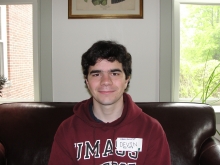You are here
Let's build a robot!
When people hear the word robot they probably think of something like the photo below, a humanoid machine that acts like a person, but is smarter and stronger in nearly every way; robots that are self-aware and may be preparing to rise up against their creators.
The primary goal of the robots from the above picture is to help people. Everything they do, every action they take, is intended to make their caretaker's life easier. It's important to note, that in today's world, every robot we have built was designed with the intention to make someone's life easier and safer. Whether they are the robots Ferrari uses to assemble its cars or the robots moving among the shelves in a warehouse, they are all making a life easier.
This summer, I am one of three students on a design team building a machine whose purpose is to make the lives of researchers and scientists worldwide easier. For centuries now, experts in their respective fields have traveled globally to collect the data needed to test their hypotheses. Whether they must travel to the streets of New York City, to the northern tundra, or to the deepest reaches of the ocean, they have done it all in the name of science.
More often than not, these professionals find themselves having to collect data in inhospitable places, such as around an active volcano or in the Amazonian rainforest. The ecosystems in these places often makes data collection a challenge. There may even be places from which they need data but the location is inaccessible. The goal of our design team is to build a robot that will offer scientists an opportunity to access these locations.
![[Proposed robot design]](/sites/default/files/REU_Carroll2_2013.jpg) This summer is more of a test run than anything else. Step one is designing the overall system: the robot, how it will move, the power system, and how it will collect data. This, by the nature of design, takes a few weeks; every part must be analyzed to ensure it will efficiently perform the function that is required of it. After three weeks, the design is nearly 100 percent complete. Below is an image of the system that will carry the sensors. For the test run, it will be suspended above a secondary forest by two cables and driven by a third cable.
This summer is more of a test run than anything else. Step one is designing the overall system: the robot, how it will move, the power system, and how it will collect data. This, by the nature of design, takes a few weeks; every part must be analyzed to ensure it will efficiently perform the function that is required of it. After three weeks, the design is nearly 100 percent complete. Below is an image of the system that will carry the sensors. For the test run, it will be suspended above a secondary forest by two cables and driven by a third cable.
The next step in the project is the proof-of-concept phase. During this stage of the project, we will build a smaller replica of the system and install it by the Maintenance Garage here at Harvard Forest. We will put the robot through its paces, running it back and forth between towers, have it collecting data, and ensuring that it works smoothly and efficiently. This will be accomplished within the coming weeks.
The final step is to implement the robot in the field. We hope to have this accomplished by week eight or nine of the program so there is time to collect data we can analyze. This final step will be similar to the proof-of-concept phase of design, only we will build the full-sized robot.
![[Photo courtesy of Faith Neff - Location of robot (prior to construction)]](/sites/default/files/REU_Carroll3_2013.jpg)
![[The lab]](/sites/default/files/REU_Carroll4_2013.jpg) One of the really nice aspects of this project is it provides a blend of computer work as well as field work. For the past few weeks, I have been hunched over a computer screen, working out the kinks in the designs, calling other engineers, and ordering parts. As more and more of the parts come in, however, I will find myself out in the field assembling the robot and ensuring it will work as intended.
One of the really nice aspects of this project is it provides a blend of computer work as well as field work. For the past few weeks, I have been hunched over a computer screen, working out the kinks in the designs, calling other engineers, and ordering parts. As more and more of the parts come in, however, I will find myself out in the field assembling the robot and ensuring it will work as intended.

Quirky Q&A with Devin
When are you taking your next vacation and where are you going?
I don’t know when I am taking my next vacation, I find that school and work keep me rather busy. That is not to say I haven’t planned out a vacation. For my next vacation I would absolutely love to spend a few weeks traveling through Colorado ski resorts, skiing a new mountain every day from sun up to sun down.
What nocturnal animal would you be if you had to choose and why?
I would choose to be an owl. The silent observer of the forest. The can also fly without making a sound and turn their heads up to 180° which is pretty darned cool.
Would you rather travel by train, car, plane, or ship?
I would much rather travel by train than a car, plane, or ship. I feel that with a train one gets to take a more scenic route that they wouldn’t see on a plane or a ship and that unlike a car, one can get up and stretch their legs rather than be cooped up for hours on end.

![[Image courtesy of http://www.industryleadersmagazine.com]](/sites/default/files/REU_Carroll1_2013.jpg)
